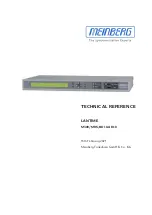
© MOBATIME
86 / 124
801214.10
8.11 Synchronous Ethernet (SyncE)
With SyncE, devices in an Ethernet Network can synchronize their clock to the
frequency used to transmit the network packets. The DTS 4160 supports SyncE
compatible to ITU G.8262/Y1362. It is available on 3 different network interfaces (see
Appendix A Connection diagrams).
The DTS 4160 can be configured to run as a SyncE Master only. It communicates via
the Ethernet ports by sending Layer2 packets (ESMC), with the current quality level
information.
Connectors:
Ethernet via 1x SFP slot and 2x RJ45 ports
referring to Appendix A Connection diagrams
Transmission mode:
Layer2
Quality Level:
In synchronized state the DTS 4160 sends out the quality level
PRC.
8.12 E1
E1 is a European digital transmission format specified by the ITU-T. The E1 signal
format carries data at a rate of 2.048 Mbit/s. It is composed of 32 channels and the
data rate supported by each channel is 64 kBit/s. The DTS 4160 is equipped with one
E1 interface.
Outputs:
1x unbalance E1 output (BNC 75 Ohms TX and RX)
1x balanced E1 output (RJ48 jack)
Coded:
HDB3 coding format
Features:
Supports CRC4
DTS 4160 meets the following standards:
G.813: when OCXO MV197-B5G is installed
G.812: when OCXO MD-1731-DAT is installed
G.811: when Rubidium is installed and synchronized with GNSS.
8.13 Oscillator
The DTS 4160 is available with different types of internal oscillators:
-
Rubidium :
The rubidium oscillator provides the ability to extend the hold-over period for operation
compatible to the G.811 in case off a temporary loss off the time source.
-
OCXO HQ:
This oscillator provides the ability to extend the hold-over period for operation
compatible to the G.812 in case off a temporary loss off the time source.
-
OCXO:
This oscillator provides the ability to extend the hold-over period for operation
compatible to the G.813 in case off a temporary loss off the time source.
All of these oscillators are disciplined to the time source available (such as GNSS,
PTP, E1…) .
During the start-up, the oscillator has to warm-up. In this warm-up time the oscillator is
not stable enough. This is the reason why the device waits for the oscillator to
lock/stabilize. This takes normally up to 10 minutes. In the worst case this can take up
to 2 hours, but this is really rare.
For operation with E1 line, the rubidium oscillator is the recommended option.
Содержание 122031
Страница 22: ...MOBATIME 22 124 801214 10 MOBA NMS Tab Overview Frame Time time state...
Страница 78: ...MOBATIME 78 124 801214 10...
Страница 121: ...MOBATIME 121 124 801214 10...
Страница 122: ...MOBATIME 122 124 801214 10...
Страница 123: ...MOBATIME 123 124 801214 10...















































